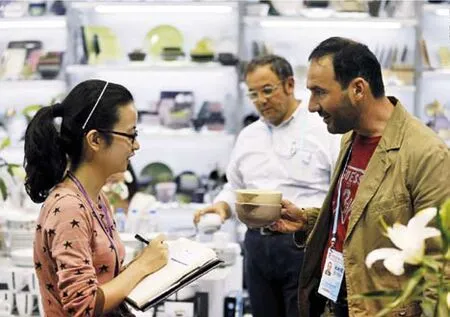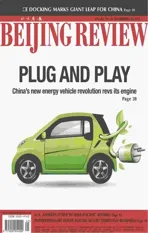Not All Fun at the Fair
2011-10-14ByHUYUE
By HU YUE
Not All Fun at the Fair
By HU YUE
Chinese exporters attempt to ride out the downturn and look for opportunities at the 110th Canton Fair
As growing uncertainties hang over China’s trade front, a closer look at the latest Canton Fair, a barometer of China’s foreign trade, can provide an insight on how exporters are faring.
Offcially known as the China Import and Export Fair, the biannual Canton Fair is held every spring and autumn in Guangzhou, capital of south China’s Guangdong Province, and each fair has three phases. The 110th Canton Fair, held from October 15 to November 4, attracted more than 24,000 enterprises from home and abroad. Its first two phases witnessed export deals worth around $33.18 billion, up 3.2 percent over the spring fair.
With more foreign buyers roaming its vast halls, the bustling trade fair, coming amid the simmering debt crisis in Europe and economic weakness in the United States, sent out a signal that exporters were recovering some lost ground, though a bumpy road might still lie ahead.
“The export outlook is less promising given lackluster external demands and domestic costs inflation,” said Liu Jianjun, a spokesman of the fair. “But buyers from emerging markets like India and Brazil have increased significantly, while orders from developed countries remained stagnant.”
“More disturbing, though, is the fact that foreign purchasers tend to sign short-term and smaller-scale contracts out of fears of an appreciating yuan,” said Liu.
The Chinese currency has gained more than 4 percent in value against the dollar so far this year, making a dent to competitiveness of Chinese exports.
“We suggest exporters take countermeasures to fend off currency risks, such as switching to yuan settlement or signing contracts locking up exchange rates,” he added.
Lingering concern
For most Chinese exporters, September and October should be the busiest months of the year, as Christmas orders keep their machines humming. But this year, the euphoria seems to be fading.
“The festive orders are coming in, but at least 10 percent fewer than last year,”said Zhou Zongyou, General Manager of Guangdong Eagle Gifts Co. Ltd. “We attend every session of the Canton Fair, and obviously, foreign traders are becoming more hesitant to place orders.”
“Due to surging labor costs and raw material prices, we had to raise product prices by 5 percent,” he added. “But even such modest increase is mostly unacceptable to buyers.”
But Zhou still keeps his fngers crossed for a brighter export market. “I hope the current downturn is only temporary, and a substantial turnaround is on the way,” said Zhou.
Zhou’s experience paints a vivid picture of what is happening to China’s export sector. In September, exports went up 17.1 percent to $169.67 billion, while imports amounted to $155.16 billion, up 20.9 percent from a year ago, according to data from the General Administration of Customs.
“It is only a matter of time before the turmoil in the United States and euro zone feed into China’s trade economy,” said Ren Xianfang, an analyst with the IHS Global Insight, a global consulting frm.
“September is traditionally a poor month for trade, but whether this month like September 2008 marks the start of a sharp decline depends largely on developments in the euro zone,” she said.
In the wake of the global fnancial crisis, China’s exports experienced an acute crunch in 2008, causing massive factory closures and painful layoffs, as well as putting a serious drag on economic growth.
“We don’t expect China’s exports to collapse as sharply as they did three years ago, but it is highly likely that external demands will decline in the coming months,” said Zuo Xiaolei, chief economist with the Beijingbased China Galaxy Securities Co. Ltd.
Zuo predicted that monthly export growth will drop to a single-digit rate in the fourth quarter.
Hu Yunjiang, a researcher at the Development Research Center of the State Council, pointed out that Chinese exporters have problems of their own.
“China’s exports are mostly low-end products with less added value, and the manufacturers still have a long way to go to move up the value chain,” he said.
On the defensive
Since orders from the West are declining, many manufacturers are looking to emerging markets.

CHEN YEHUA
Zheshang Securities Co. Ltd. conducted a survey of more than 20 Chinese exporters at the 110th Canton Fair and found that their orders from India, Viet Nam and the Middle East increased 30 percent from last year, contributing one third to their total businesses.
“Our orders from Russia and Latin America are running up quickly,” said Huang Tao, a sales manager with the Qingdao Sino Chemical Co. Ltd., a Shandong Provincebased arts and crafts maker. “This effectively made up for a slump in demand from the United States.”
“The success stems from vigorous efforts to improve marketing network and designs tailored to customer needs in those markets,”he said.
Meanwhile, many companies are also trying to tap domestic markets where the solid demands provide an insurance of profts. Among them is the Shuangma Plastic Industry Co. Ltd., a producer of plastic household products in Taizhou, Zhejiang Province.
“Domestic consumers are increasingly opening up their wallets thanks to steady income growth,” said Zhang Jianying, a sales manager of the company. “We started exploring domestic markets a few years ago, and are therefore more able to tide over the current export downturn.”
“But winning the home markets would require greater efforts to enhance branding and deal with competition from counterfeit products,” he said.
Innovation matters
For many far-sighted exporters aiming to graduate from mere low-cost manufacturing, innovation is no longer an option, but a necessity.
“Now is the best time for companies to upgrade their technologies and improve product quality,” said Huo Jianguo, President of Chinese Academy of International Trade and Economic Cooperation under the Ministry of Commerce. “Those less competitive players would be forced out of the market.”
Some market-savvy firms are already riding the innovation wave, such as Tangshan Huida Ceramics Group Co. Ltd., a maker of sanitary ceramic products maker based in Hebei Province.
Like many other export frms in China, the company received a deadly blow from the fnancial crisis in 2008.
“We even had to suspend some assembly lines as export orders shrank by half,” said Xing Jinrong, deputy general manager of the company. “The crisis became a powerful catalyst for us to transform the business model.”
The company expanded its product line, making a push into furniture and kitchenware. But what set it apart from competitors was a deep-rooted commitment to R&D. In 2010, the company set up three R&D centers in Beijing, Shanghai and Tokyo, respectively, all engaged in creative product designs and innovations.
Meanwhile, the company reduced production as an original equipment manufacturer, and spared no effort to heighten its brand recognition. It established subsidiaries in Los Angeles and Dubai to build a firm overseas market foothold.
Those stiff efforts are paying off, as the company has become the country’s largest exporter of sanitary ceramic products.
Import buoyancy
As China’s economy remains a calm port amid the global financial storm, its imports are picking up momentum, benefting a number of trade partners.
The Chinese market means plentiful opportunities for U.S. retailers as China’s growing middle class becomes more capable of consumption, said Mathew Shay, President and CEO of the U.S. National Retail Federation.
“We brought made-in-China products to the U.S. market a long time ago. Now we hope U.S. retail companies can flourish in Chinese market,” he said.
Shay is not alone. A total of 529 foreign enterprises including Microsoft and GE, from 49 countries and regions came to the fair’s import exhibition in the hope of selling more goods to Chinese consumers.
Pierre-Dominique Oubrier, President of Carrefour Global Sourcing, said Chinese consumers have showed growing interest in imported products, as well as higher requirements for product designs and qualities.
Okitsugu Nieda, Vice President of the Japan Council for Promotion of International Trade, said he hopes China can encourage more local companies to attend the fair to help foreign companies fnd proper partners and distribution channels.
The 110th Canton Fair also extended a helping hand to Japanese exports by setting up booths for 22 companies from the quake-ravaged Miyagi, Fukushima and Iwate prefectures to lure Chinese customers.
As they gear up to redress the trade imbalance, Chinese policymakers have handed out generous incentives to widen imports, such as lower import tariffs and greater import credit. In 2010, the country’s imports totaled $1.4 trillion, making up 10 percent of the world’s total, compared with only 4.4 percent in 2002.
“China’s efforts to stimulate imports played a signifcant role in combating global financial crisis,” said Harsha Vardhana Singh, Deputy Director General of the World Trade Organization, on sidelines of the fair.
“I believe the world will continue to beneft from China’s growth and its contribution to international trade as well as to the multilateral trading system,” he added.
“Import growth will also slow in the fourth quarter, but is likely to hold up better given the relatively more robust domestic demand,” said Zheng Xinli, Vice Chairman of China Center for International Economic Exchanges.
It would better serve the economic rebalancing if China can import more advanced equipment, high technologies and resources, Zheng said.
